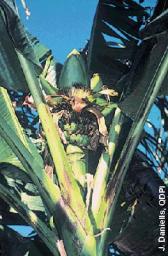This article was originally published on 28 August 2013
The recent publication of a revision of the Musa sections will come as a surprise to those who thought that the Rhodochlamys section had already been merged into the Eumusa section, and the Australimusa one into Callimusa. Wikipedia, for one, thought that the merge had taken place in 2002 after a molecular analysis found that Musa species segregated into two groups instead of four. Well, it hadn’t. Not only did it require more than one molecular study to topple the morphology-based classification, any revision of the sections also had to be done by the book, which is what the Finnish botanist Markku Hakkinen did by publishing his revision in Taxon. In the process, the name Eumusa was changed to Musa to conform to the botanical code1 (see Welcome to the world of taxonomy).
A section is a taxonomic rank below the genus and above the species. It’s typically used to highlight relationships within a genus. For bananas, the first attempt to tidy up the Musa genus dates back to 1887, when the French botanist Paul Sagot recognized three groups: edible bananas, ornamental bananas with upright inflorescences and brightly coloured bracts, and giant enset species, which have since been given their own genus. Sagot did not give names to his sections, but a few years later the British botanist John G. Baker classified them as subgenera and respectively named them Eumusa, Rhodochlamys and Physocaulis.
Then came Ernest E. Cheesman, the prescient British botanist who realized that the classification of banana cultivars needed a system different from the Latin binomials used for wild species. In 1947, he divided the genus Musa into four sections based on the chromosome numbers and morphological characteristics of the species: those that have 11 pairs of chromosomes (Eumusa and Rhodochlamys) and those that have 10 pairs (Australimusa and Callimusa). He said that he deliberately used the term section, rather than subgenus, to avoid the implication that the groups are of equal rank. In 1976, another British botanist, George Argent, added the section Ingentimusa to accommodate a lone species, Musa ingens, which has 7 pairs of chromosomes.
Calls to merge the Rhodochlamys section into the Eumusa one predate phylogenetic analyses. Cheesman himself noted that he was “inclined to regard the division between Eumusa and Rhodochlamys as unessential, though it is convenient to maintain as long as it remains as well marked in the field as it is at present”. The ease with which some Rhodochlamys species interbreed with Eumusa species and produce fertile hybrids – an indicator of relatedness – has also been known for a while. It has even been suggested to use Rhodochlamys species in breeding schemes. One trait that has attracted the attention of breeders is their unusual adaptation to dry and hot spells, at least among wild banana species. The plants die back and start producing new shoots when the rain starts again. I’m not sure that this is the kind of adaptation to drought banana farmers are looking for, but the section also has species that are apparently resistant to black leaf streak and Fusarium wilt. The merging of the sections might revive interest in screening the species in the former Rhodochlamys section for their resistance to pests and diseases.
The new Callimusa section predictably includes the species in the former Australimusa and Callimusa sections. It also takes in the sole representative of the Ingentimusa section, Musa ingens. I find it confusing that the merged section is also called Callimusa, but maybe somebody will one day rename the section. Come to think of it though. Can a validly published and legitimate name be changed?
The species that currently make up each section are listed in the Musapedia page on Musa sections.
Addendum: I was referred to Recommendation 47A.1 of the botanical code to distinguish the merged Callimusa section. The code says that "when an alteration as mentioned in Art. 47 has been considerable, the nature of the change may be indicated by adding such words, abbreviated where suitable, as “emendavit” (emend.) followed by the name of the author responsible for the change". In this case, an accepted formulation would be: Musa sect. Callimusa Cheesman emend. Häkkinen.

